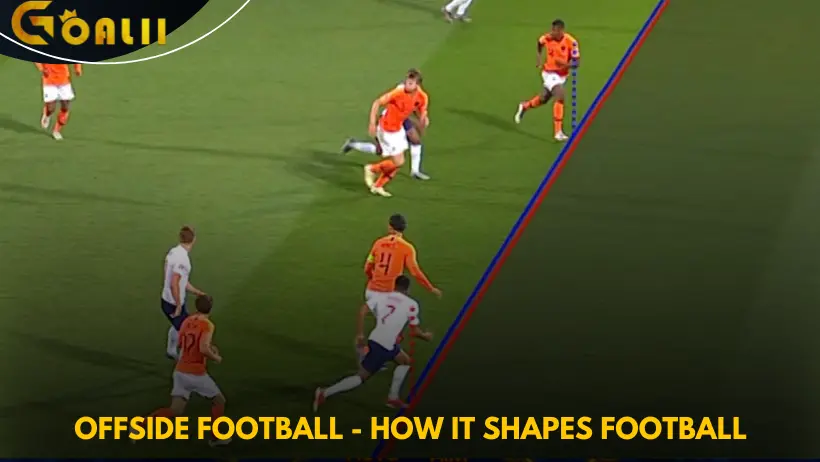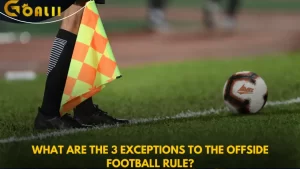Offside football is one of the most familiar, important, complex, and controversial rules. Although it is just a simple rule to prevent attacking players from taking advantage of their position to score goals, offside football has created many controversies and key decisions in football history. Understanding the offside rule not only helps players play more effectively but also gives fans a deeper insight into the tactics and complexity of the game.
The offside football rule is one of football’s basic but extremely important rules, regulated by FIFA and applied globally. The main purpose of this rule is to prevent attacking players from taking advantage of their position to score goals easily, thereby maintaining fairness in the game.

A player is considered to be in an offside position when their stance and position combine the following factors. Let’s explore with GOGOJILI.
- The player must be standing in the opponent’s half of the field.
- At the moment of the teammate’s pass or the last touch of the ball, the player is standing closer to the goal line, also known as the touchline, than the ball and the second to last defender of the opponent (excluding the goalkeeper).
- The player participates in the ball situation by directly interfering with the match, influencing the opponent, or taking advantage of the position to score a goal.
Offside football is one of the rules that create the tactics and complexity of football. The linesman is the person who directly monitors and decides on offside situations, with the support of VAR technology in important matches, to ensure the correct decision.
Application of the offside rule in football
Teams use the offside rule as part of their defensive and offensive tactics, creating dramatic and strategic matches.

In defense
Teams often use the offside trap as an effective defensive method. The offside trap is when defenders move forward simultaneously to force the opposing attackers into an offside position. This tactic requires close and rhythmic coordination between the defenders, and if successfully implemented, it can disrupt dangerous attacks by the opponent.
In attack
Understanding the offside football rule helps attacking players choose the right position to break the opponent’s offside trap, creating scoring opportunities. Smart runs and coordination between the passer and receiver can help the team take advantage of gaps in the opponent’s defense without falling into an offside position.
Read more: What Is Extra Time in Football? Critical Knowledge Must Know
Impact on the Coach’s Overall Strategy
The offside football rule in football also affects the way the team builds its overall strategy. Coaches must carefully calculate how to use the offside rule to their advantage and limit the opponent’s ability to attack. This includes training players to understand and practice tactics related to offside, such as how to create an offside trap or how to break the offside trap.
The impact of the Offside Football rule on the outcome of the match
This is not only a rule to ensure fairness but also affects the tactics, spirit of play, and the final result of the match. Below is a specific analysis of the impact of the offside football rule on the outcome of the match:
Impact on player psychology
An offside decision in football can cause great frustration for players, especially when a goal is disallowed due to an offside error. This not only affects the individual psychology of the player caught offside but can also affect the overall spirit of the team. Conversely, when a team successfully executes the offside trap, this can boost their morale and confidence, creating momentum for quick and effective counterattacks.
Deciding the outcome of the match
The offside football rule in football often plays a key role in deciding the outcome of a match. A goal disallowed for offside or a successful offside trap can completely change the outcome of the match. Especially in important matches such as finals or matches where the score is very close, an offside situation can be the deciding factor in winning or losing.
The intervention of VAR technology
With the support of VAR technology, the offside football determination becomes more accurate, but at the same time, it increases the tension in each decision. VAR can identify offside situations in football with high accuracy, even in very close cases. This helps to reduce refereeing errors but, at the same time, can prolong the match, disrupt the rhythm, and affect the excitement of the audience.
The offside football rule not only shapes the tactics of teams but also creates dramatic and emotional moments on the pitch. Understanding and complying with the offside rule in football is not only the responsibility of players and referees but also the key to maintaining fairness and sportsmanship in every match. Sports betting’s article helps readers better understand the offside rule in football matches.
What are the 3 exceptions to the offside football rule?

There are a number of exceptions to the offside football rule where there is no offside if a player receives the ball. These three instances are:
Goal kick
As long as the goal kick is taken from the field, rather than being kicked off the goalkeeper, any player on the opposite side of the field who receives the ball directly from the goalkeeper cannot be offside.
Throw-in
Offside football cannot be called for a direct throw-in. If the player receives the ball directly from the throw-in, despite his position in relation to the opposing defenders, it is not considered offside.
Corner kick
A corner kick cannot be considered offside if the ball is passed directly to a player, regardless of whether the player is nearer to the goal than two of the opposing defenders.
However, there is a caveat to all three of these exemptions. If the ball is passed to a teammate in an offside position, who then passes it to a player who is closer to the goal than two opposing defenders, that player is in an offside position because he indirectly received the ball from a throw-in goal kick, or corner kick.
Offenses and Sanctions
In case of an offside football offense, the referee will give an indirect free kick at the place of the offense, whether in the player’s own half of the field of play.
Any defending player who moves off the field of play without the permission of the referee shall be considered to be offside or on the goal line or touchline until the next break or until the defending team has taken the ball up to the halfway line or outside the penalty area. If the player has deliberately left the field of play, the player must be cautioned as soon as the ball goes out of play.
An attacking player may step or stay off the field of play for the purpose of coming out of active play. Any time a player rejoining play from the goal line becomes involved prior to the next whistle or when, after playing the ball toward the midfield line, the defending team’s penalty area, the player is regarded as being on the goal line regarding offside football.
An outsider who leaves the field of play then re-enters without the permission of the referee and without being penalized for offside and getting an advantage must be penalized a yellow card.
If an attacking player stays up to the goal line and now inside it when the whole ball reaches the goal, a goal has to be given, exclusion of the player commits an offside football offense or a Law 12 offense results in the indirect or direct free kick.

Hello everyone, I’m Maria Reyes, a betting expert with over 6 years of experience in the online casino world! I’m the CEO & Founder of GOGOJILI.COM, launched in February 2020, with a mission to bring exclusive promotions and top-notch thrills to Filipino players. Plus, we’re the official first-level agent site recognized by the GOGOJILI betting platform. A heartfelt thank you to all for your support, I’m thrilled to welcome you to our site!
